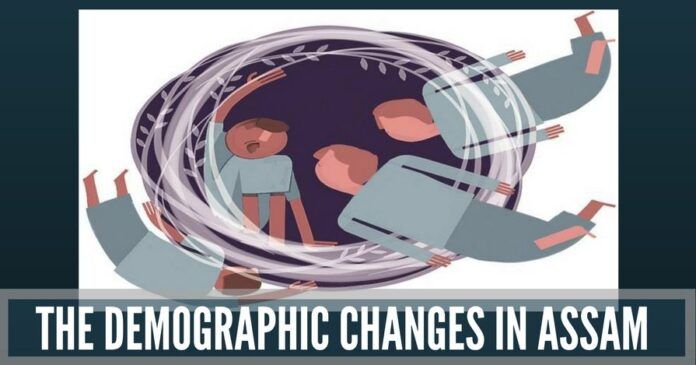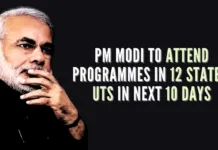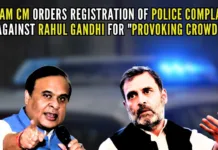
At least four districts will turn into Muslim-majority ones from being Hindu-majority for decades as a result of the illegal immigration
When a subsidiary remark is sought to be transformed by certain people into the main narrative, there can be only one aim: To muffle the principal issue because it inconveniences the engineers of such transformation. Thus, when the Chief of Army Staff, General Bipin Rawat, flagged the demographic changes happening in Assam due to illegal immigration from neighbouring Bangladesh and cited the example of parties such as the All India United Democratic Front (AIUDF) that have benefitted from the phenomenon, opposition parties and assorted Army-baiters immediately condemned the General for ‘indulging in politics’. They did not naturally appreciate him for speaking the truth on the influx of outsiders — which incidentally has also been a cause of security concern for the nation.
The report, by the Court Commissioner Upamanyu Hazarika, suggested measures to contain the “continued aggression of illegal migrants”, including the restriction on the sale of land and other immovable property to only those who had been citizens in 1951
So, let’s talk facts and avoid hyperbole or motivated twists.
Fact number one: In 2005, a three-judge Bench of the Supreme Court, struck down the Illegal Migrants (Determination by Tribunals) Act of 1983, calling it the “biggest hurdle” and the “main impediment” in the identification and deportation of illegal migrants from Bangladesh. Implicit in the verdict was the belief that such migration existed in a big way.
Fact number two: The Justices not just concurred with the enormity of the situation but also deemed it harmful. They called it an “aggression” and said that the immigration had made the people of Assam “wholly insecure”. They also stated that the “panic generated thereby had created a fear psychosis”. They went on to add that the large-scale crossing-over had impacted not just Assam but other regions of the North-East as well.
Fact number three: The findings of a recent report by a Supreme Court-appointed panel showed an alarming increase in the number of electors in certain areas of Assam, and that immigrants had been registered as voters even though their nationality remained to be determined.
Fact number four: The report, by the Court Commissioner Upamanyu Hazarika, suggested measures to contain the “continued aggression of illegal migrants”, including the restriction on the sale of land and other immovable property to only those who had been citizens in 1951 (and their descendants).
Fact number five: The Hazarika report said categorically that the “illegal migrants are largely Muslims and the percentage of increase in the Muslim population (in Assam) is a benchmark for the increase in migrant population. It expressed deep dismay over the political play, observing: “In the face of glaring facts, continued aggression of illegal migrants and changing demography, what are the options available (for residents), more so when the Government acts only for the benefit of such migrants”.
The Bangladeshi illegal immigration has had security implications for India. Several armed insurgent groups such as the ULFA based themselves in Bangladesh
Fact number six: The number of Hindus in some of the most vulnerable districts of the State — Goalpara, Dhubri, Bongaigaon, Kamrup and Nagaon — has been falling drastically while that of the Muslims has registered sharp increases. This is primarily due to the influx of Bangladeshi immigrants. According to some studies, the Hindu population in Goalpara, for instance, was a little over 54 percent in 1951; it came down to about 38 percent in 2011 and is expected to further decline to near 23 percent by 2051, going by current trends. Similar is the case of Nagaon: from 59 percent in 1951 to 45 percent in 2011 and projected to be 30 percent in 2051. Going by these figures, at least four districts will turn into Muslim-majority ones from being Hindu-majority for decades as a result of the illegal immigration.
Fact number seven: The Muslim population has gone up from 43 percent in 1951 to 56 percent in 2011 in Goalpara; in Nagaon, the rise has been from 40 percent to 55 percent; and in Kamrup, Muslims comprised 39 percent in 2011, up by 29 percent in 1951.
Fact number eight: Independent estimates put the number of illegal immigrants in Assam at 1.5 million to two million — or roughly 25 percent of the total Muslim inhabitation in the State. Obviously, this has led to drastic changes in the demographic profile of Assam, created social discord and unrest.
Fact number nine: The six-year-long Assam agitation, spearheaded by the All Assam Students Union was a manifestation of the anger among the people of the State over the devastating changes that Bangladeshi migrants were wreaking on society there. The union later metamorphosed into the political Asom Gana Parishad which won the Assembly election on the crest of the anti-immigration mood.
Fact number ten: These illegal immigrants have managed to secure all sorts of State-documents and have availed various Government schemes (both Central and State-specific), thus largely cornering the benefits and leading to legal citizens losing out. The schemes include MGNREGA, National Rural Health Mission etc.
Fact number eleven: The Bangladeshi illegal immigration has had security implications for India. Several armed insurgent groups such as the ULFA based themselves in Bangladesh. It was not just a matter of sanctuary there (which has, of course, come under strain ever since Sheikh Hasina took over as Prime Minister and responded positively to New Delhi’s concerns). These outfits have been able to operate because of the networking they created among the illegal immigrants living in India. Besides, some of these organisations are said to have developed contacts with known anti-India groups such as the Harkatul-Jihadi-e-Islami (HuJI) and even Pakistan’s Inter-Services Intelligence (ISI).
Note:
1. The views expressed here are those of the author and do not necessarily represent or reflect the views of PGurus.










